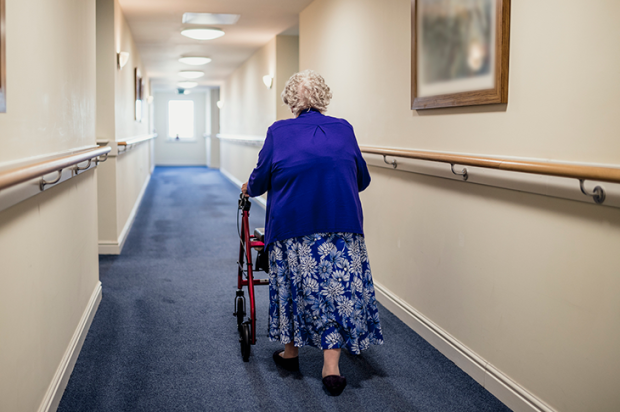For millions of middle-aged children, finding good care for their parents is akin to a Grail quest — and just as unlikely to succeed. How can you tell if a care home is good? There are so many horror stories of neglect, abuse and even deaths. Most people rely on ratings from the Care Quality Commission (CQC). But when the care regulator says a home is ‘good’, does that mean it is actually good? In fact, as I discovered, it could mean anything.
The CQC’s coveted ‘good’ grade is supposed to be a reassuring measure. It should tell you that your relation will be safe, because a team of inspectors has given the home its official approval.
Sad to say, this is extremely optimistic. Our care-home regulatory regime, far from being a guarantor of quality, is fundamentally flawed. ‘Good’ homes turn ‘inadequate’ in weeks, casting doubt on the veracity of ratings. And thousands of others are officially substandard with poor care and neglect practically endemic, calling into question the effectiveness of the inspection regime.
The CQC admits it struggles to maintain its schedule of inspections, so that third parties, rather than inspectors, often reveal what is really going on. Among the worst homes are dozens that were, until recently, on the CQC’s ‘good’ list. Following deaths, serious injuries, abuse, neglect or lack of staff, a sound of slamming stable doors has echoed around the country as they were downgraded to ‘inadequate’. It happens so regularly that one wonders if any ‘good’ home is the sort of place you would want to see your mother, or anyone else’s, living in.
Glowing reports are published, detailing how there were ‘hugs’ all round between staff and residents. This might not be everyone’s idea of a good time, but it is supposed to convey the idea that this is a good home. A few weeks later, the regulator changes its mind. Now it does not have a good word to say about this hitherto ‘haven’ for the elderly. There is no mention of ‘hugs’ in a new report, which notes that residents’ dignity is not respected. This is an actual case involving a Devon-based home which received two reports this year: ‘good’ in February and ‘Inadequate’ in July. And again, it was somebody else who told the CQC that a ‘good’ home was actually bad. After an ‘incident’ in which a resident was not given ‘timely medical treatment’, ‘concerns’ were raised by local healthcare professionals.
Reports on around 270 homes branded ‘Inadequate’ by the CQC show that more than 100 of these were previously rated ‘good’, and in at least 60 per cent of cases, the CQC returned early because of third-party concerns — often less than 12 months after a previous inspection. So how can we possibly be sure about the 11,000 other homes currently rated ‘good’?
A key problem is the system. CQC inspectors may spend as little as one day in two years at a care home. And the vast majority of homes are quite capable of putting on a good show. There are some, of course, so dreadful that they cannot rouse themselves even when the CQC is at the door, but these are rare.
Along with a group of other concerned relatives, I was at a care home early one day to meet the manager when the CQC arrived at the front door. It was the sort of home with matching scatter cushions, cafés, and glossy brochures talking about dementia champions — shame about the care. The manager raced away to intercept the inspectors. Meanwhile phone calls brought in off-duty staff, and residents were hoiked out of bed, to be chattered to by staff who usually spent their days closeted together in the nurses’ station, trying not to hear the plaintive cries of their ageing charges. The residents were unaccustomed to being dressed, let along addressed at that time of day and looked around bemused at the lounge, which had been festooned with balloons.
‘It’s not usually like this,’ I told an inspector. ‘I expect it’s someone’s birthday,’ she replied. I snorted in reply.
Where is the market in all this? Care is largely marketised. So why aren’t good homes sweeping away substandard providers with a better product? Because the care market does not act as a market should. Consumers, homes and even the regulator all effectively collude to bolster bad practice.
Consumers (in the shape of residents and their families) are heavily invested in the product — even if it is terrible. In every damning CQC report, you will find people telling inspectors how happy they are with the care. Despite abuse, neglect, even suspicious deaths, there is always a guilt-ridden daughter saying it is fabulous. When a care home is forced to shut, it is even worse. We should put out the bunting when a bad home closes. But instead, there is an inevitable hoo-hah and people complain that their distressed parents have to move — somewhere better.
Meanwhile, the care regulator cannot do what other regulators might. It rarely shuts businesses, doesn’t stop fees for bad care or levy huge fines. Some banks may be too big to fail — but is there any other industry, where the regulator is so desperate to keep businesses going that it will permit consumers’ safety to be placed at risk? In any other market, providers would not get paid for a bad service. Imagine a hotel demanding top dollar for filthy rooms, inedible food and surly staff. But the CQC gasps at the very idea of stopping care homes charging for bad care.
On the other side of this dysfunctional ‘market’ are the homes and care providers. Some (although by no means enough) do care deeply about their vulnerable charges. Yet there is little incentive to provide decent care when poor care attracts the same money — although the regulator is promising to start taking action against persistently bad homes.
Talk to anyone from the industry and they will claim it is all about a squeeze on local authority funding. But many homes reliant on publicly funded residents offer ‘good’ care while too many homes which rake in £1,000-plus a week from self-funding residents have never had a ‘good’ report. Money is no excuse for abuse. It is a highly lucrative industry and, according to analysts, this is a really good time to invest in care — especially if, as widely expected, the government soon turns on the cash taps.
Pity the CQC. It is trying to police a largely unregulated market with at least one hand tied behind its back. Its inspections do not have the same fear factor as Ofsted’s. CQC ratings mirror those of the schools’ inspector: outstanding, good, requires improvement and inadequate. But schools are largely publicly owned and staffed by qualified professionals, while exam results make crude comparisons possible and consumers will go elsewhere if they are unhappy. Care homes are mainly privately owned, staffed by unqualified carers, while comparisons are difficult and consumer behaviour verges on the perverse. It makes a world of difference. Last Christmas, Ofsted said 27 schools had never had a ‘good’ report. The CQC admitted later that one in eight care homes — that’s more than 2,100 — had never had a ‘good’ report. Every week, something like 40 per cent of homes fail their inspections while less than 2 per cent are rated ‘outstanding’.
Last week, Andrea Sutcliffe, the CQC’s chief inspector of adult social care, insisted: ‘Ratings on the website are valid.’ She added that ‘inspection is a key tool’ and defended the use of third party information, pointing out: ‘We can’t be there all the time.’
But that is the point. A regulatory system based on brief occasional inspections is inevitably not going to provide accurate information. Ms Sutcliffe admitted that services can deteriorate ‘quickly and dramatically’, but resisted calls for bad homes to be financially penalised: ‘Some of the things that need to be done, need money. [Stopping the fees could] pitch them into a downward spiral.’
You have to ask: if hundreds of costly annual inspections don’t produce accurate reports, why bother? Maybe the care market needs a different type of regulatory regime — one that tries to deal with the problems before they take place, rather than playing catch-up.
Consider the financial regulatory system. It also oversees largely profit-driven, private-sector organisations, dealing directly with the public — and is perhaps more relevant here than Ofsted. City regulators tried rule books and ‘principles’ before they settled on tough individual registration to raise standards. It was controversial, but the Personal Investment Authority made it more difficult to work in finance. Nothing will ever stop determinedly dodgy dealers — or carers — but individual registration makes it harder for the dishonest simply to move on to another employer. This remains the cornerstone of City regulation, along with a careful watch on institutional ethos.
Could the care regulator take a similar approach, combined with a well-publicised hotline? Anyone can currently become a carer and there is no mandatory ratio of staff to residents. In a recent report, a home employed one carer for 17 residents.
If registration were introduced, it would not eradicate every problem but it would drive up standards, as in the City. In the absence of an effective market, it would provide a check on those caring for our elderly, and on the ethos of providers. Surely vulnerable older people deserve as much protection as financial products? Care staff would have higher status and more security — attracting others into the industry. The need for constant inspections would decrease.
According to the chief inspector, the public expects care sites to be visited regularly. To what purpose, though? Ms Sutcliffe would like to see some changes such as allowing the regulator to highlight bad providers — pour décourager les autres. On care worker registration, she was guarded, but made it clear that ‘the government is not minded’ to go in that direction. There is a need for a ‘coherent strategy over health and social care,’ she said. ‘And we don’t have that at the moment.’
Got something to add? Join the discussion and comment below.
Get 10 issues for just $10
Subscribe to The Spectator Australia today for the next 10 magazine issues, plus full online access, for just $10.
You might disagree with half of it, but you’ll enjoy reading all of it. Try your first month for free, then just $2 a week for the remainder of your first year.














Comments
Don't miss out
Join the conversation with other Spectator Australia readers. Subscribe to leave a comment.
SUBSCRIBEAlready a subscriber? Log in